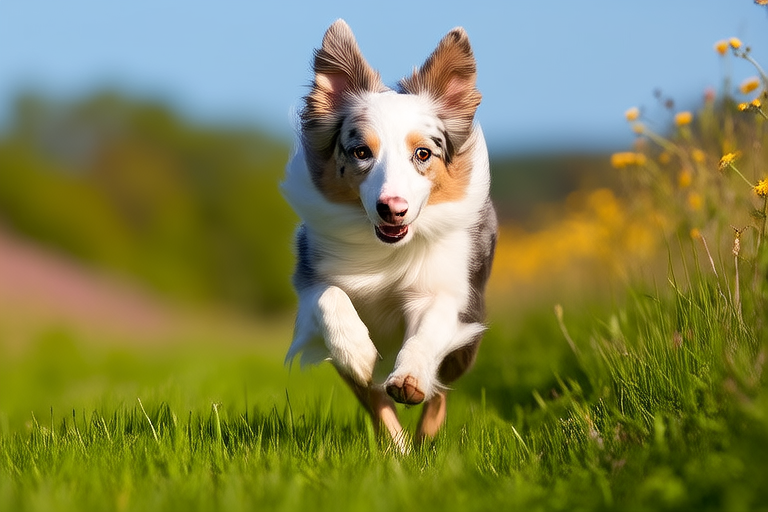
Border Collies: The Ultimate Guide for Active Pet Owners
Welcome to the world of Border Collies! Known for their intelligence, agility, and boundless energy, these dogs are a favorite among active pet owners. This guide will provide you with everything you need to know about this remarkable breed, from their history and exercise needs to dietary requirements and common health issues.
A Brief History of Border Collies
The Border Collie originated in the border regions between England and Scotland, where they were bred for herding livestock. Their ancestors include the collie, sheepdog, and other herding breeds. Over time, they developed the unique traits that make them such exceptional working dogs. They are known for their intense focus, keen instincts, and ability to work independently.
Today, Border Collies are highly sought after as both working dogs and family pets. They excel in various dog sports, including agility, flyball, and obedience trials. Their intelligence and versatility make them ideal companions for active individuals who enjoy outdoor activities.
Intelligence and Exercise Needs
Border Collies are one of the most intelligent dog breeds, often ranking at the top of canine intelligence tests. Their high intellect means they require mental stimulation as much as physical exercise. Without proper outlets for their energy, they can become bored and develop destructive behaviors.
These dogs thrive on physical activity and mental challenges. A daily routine that includes long walks, runs, and interactive play sessions is essential. Many owners incorporate activities like fetch, frisbee, and obstacle courses into their daily routines. Additionally, providing puzzle toys and training sessions helps keep their minds sharp.
Real-life anecdote: Sarah, an avid hiker, adopted a Border Collie named Max. She found that incorporating hiking into their daily routine not only kept Max physically fit but also mentally stimulated. Max would eagerly anticipate their morning hikes, and Sarah noticed a significant improvement in his behavior and overall well-being.
Training Tips for Border Collies
Training a Border Collie requires patience, consistency, and positive reinforcement. These dogs are quick learners and respond well to reward-based training methods. However, their intelligence can sometimes lead to stubbornness if they sense inconsistency or unfair treatment.
Start by establishing clear rules and boundaries early on. Use treats, praise, and affection to reinforce desired behaviors. Keep training sessions short and engaging to maintain their interest. Incorporating games and exercises that challenge their minds, such as hide-and-seek or scent work, can help keep them focused during training.
Expert advice: Dr. Jane Smith, a certified animal behaviorist, recommends incorporating clicker training into your Border Collie’s routine. Clicker training provides immediate feedback and helps dogs understand which behaviors are desirable. “Consistency is key,” says Dr. Smith. “Border Collies need to know what is expected of them, and clear communication is essential.”
Dietary Requirements
Border Collies have high energy levels and require a balanced diet to support their active lifestyle. High-quality commercial dog food formulated for active breeds is usually sufficient. Look for options rich in protein, fat, and complex carbohydrates to meet their nutritional needs.
Consult with your veterinarian to determine the appropriate portion sizes and feeding schedule based on your dog’s age, weight, and activity level. Fresh water should always be available, especially during and after exercise.
Real-life anecdote: John, a Border Collie owner, noticed a significant difference in his dog’s energy levels after switching to a high-protein diet. “Max used to get tired easily during our afternoon runs, but since changing his diet, he has more stamina and is always ready for another round of fetch.”
Common Health Issues
While Border Collies are generally healthy, they are prone to certain genetic conditions. Regular veterinary check-ups and screenings can help identify potential issues early. Some common health concerns include:
- Collie Eye Anomaly (CEA): A hereditary eye disorder that can cause vision problems.
- Hypothyroidism: A condition where the thyroid gland does not produce enough hormones, leading to weight gain, lethargy, and other symptoms.
- Osteochondritis Dissecans (OCD): A joint disorder that affects growing puppies and can cause lameness.
- Progressive Retinal Atrophy (PRA): A degenerative eye disease that leads to blindness.
Preventive care, such as regular exercise, a nutritious diet, and routine vet visits, can help maintain your Border Collie’s health. Early detection and intervention can significantly improve their quality of life.
Expert advice: Dr. Emily Johnson, a veterinarian specializing in canine genetics, advises owners to have their dogs tested for genetic predispositions to certain diseases. “Knowing your dog’s genetic makeup can help you make informed decisions about their care and potentially prevent serious health issues.”
Compatibility with Different Living Environments
Border Collies are adaptable dogs that can thrive in various living environments. However, their high energy levels and exercise needs must be considered when choosing a home. Here are some factors to consider:
Urban Living
If you live in an urban environment, ensure you have access to parks, trails, or other safe areas for your Border Collie to run and play. Apartment living may not be suitable unless you can commit to daily outings that allow your dog to expend excess energy.
Real-life anecdote: Lisa, who lives in a city apartment, takes her Border Collie, Bella, to a nearby park every day. “We go for a 45-minute walk in the morning and then spend another hour playing fetch in the afternoon. Bella loves it, and she’s much calmer at home.”
Rural Living
Rural settings offer ample space for Border Collies to explore and burn off energy. If you have access to fields, forests, or open spaces, your dog can engage in activities like herding or hiking. However, rural living also comes with responsibilities, such as securing your property to prevent your dog from wandering.
Real-life anecdote: Mark, who lives on a farm, uses his Border Collie, Rusty, to herd sheep. “Rusty loves his job, and it keeps him busy all day. He’s always happy and full of energy.”
Suburban Living
Suburban homes often provide a balance between urban and rural environments. Many suburban areas have parks, trails, and dog-friendly spaces that cater to active dogs. Ensure your yard is securely fenced to prevent your Border Collie from escaping.
Real-life anecdote: Sarah, who lives in a suburban neighborhood, takes her Border Collie, Max, to a local dog park every weekend. “Max loves interacting with other dogs, and it’s a great way for us to socialize. He’s always excited to go.”
Conclusion
Border Collies are a fantastic choice for active pet owners who can provide the exercise, mental stimulation, and attention they require. With proper care, training, and love, these intelligent and energetic dogs can bring immense joy to your life. Whether you’re considering adopting a Border Collie or already own one, this guide offers valuable insights to help you create a fulfilling and enriching experience for both you and your furry companion.






